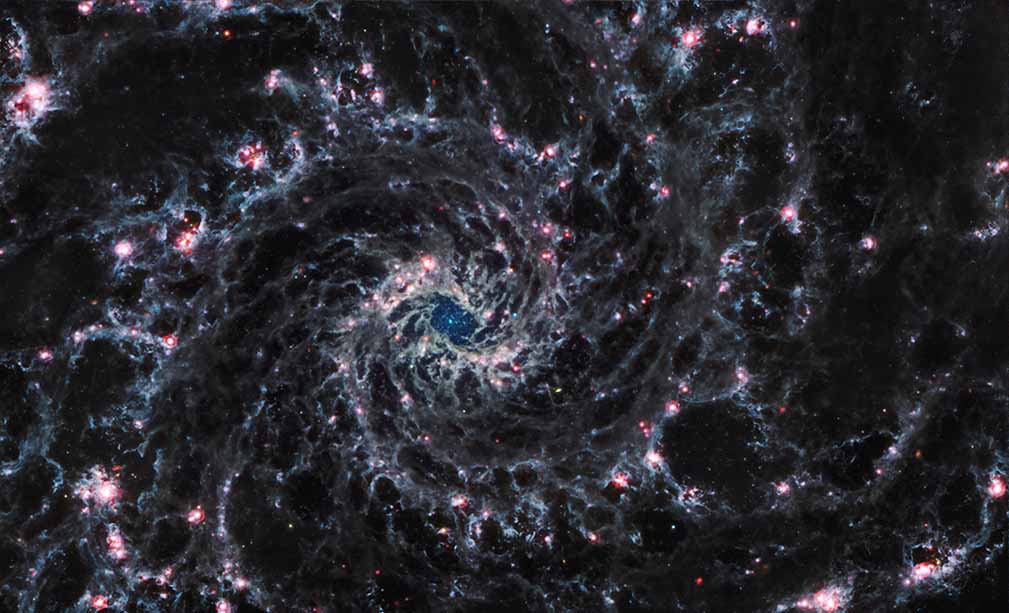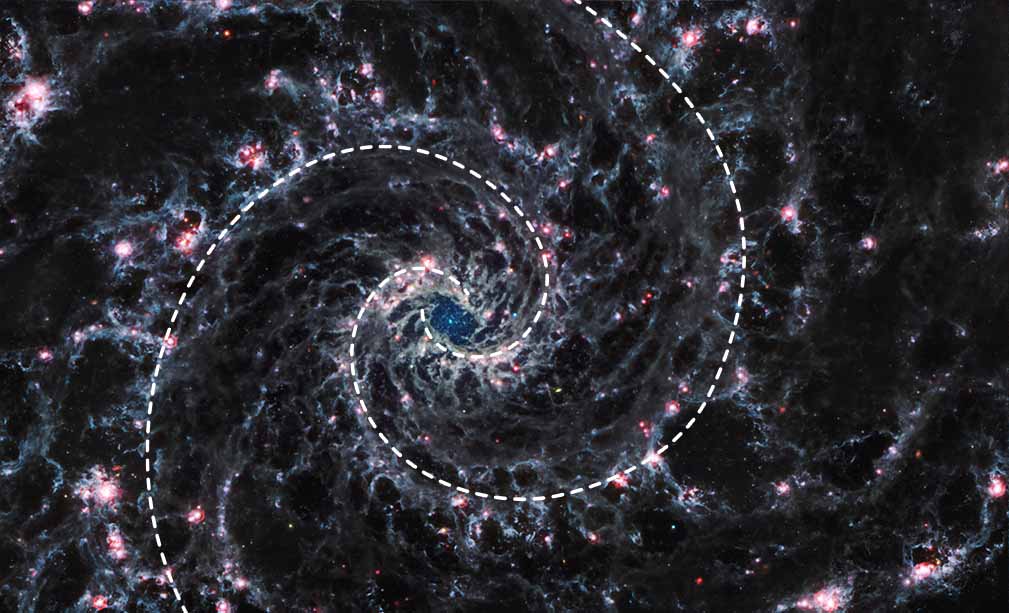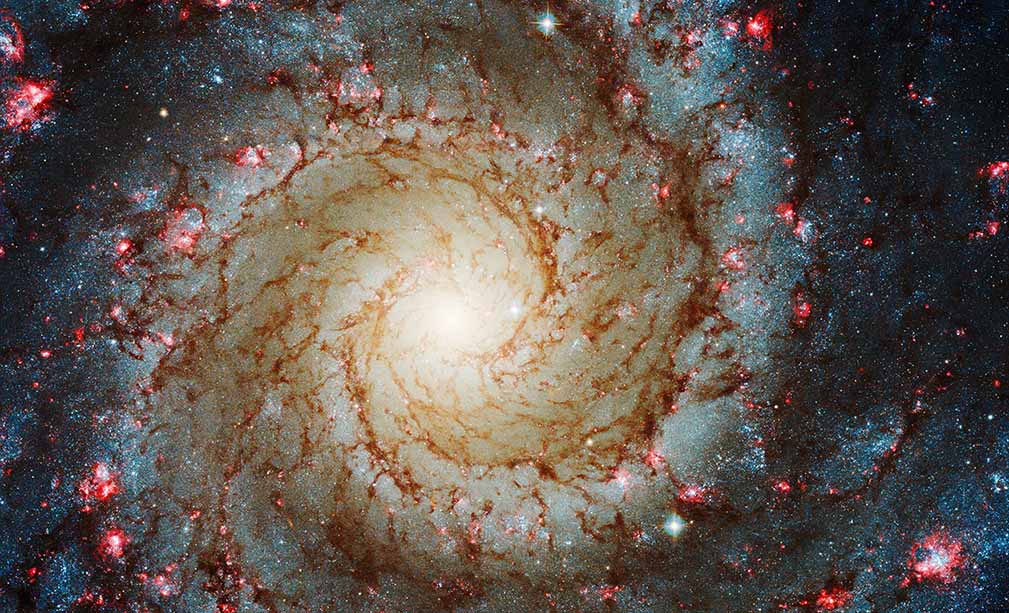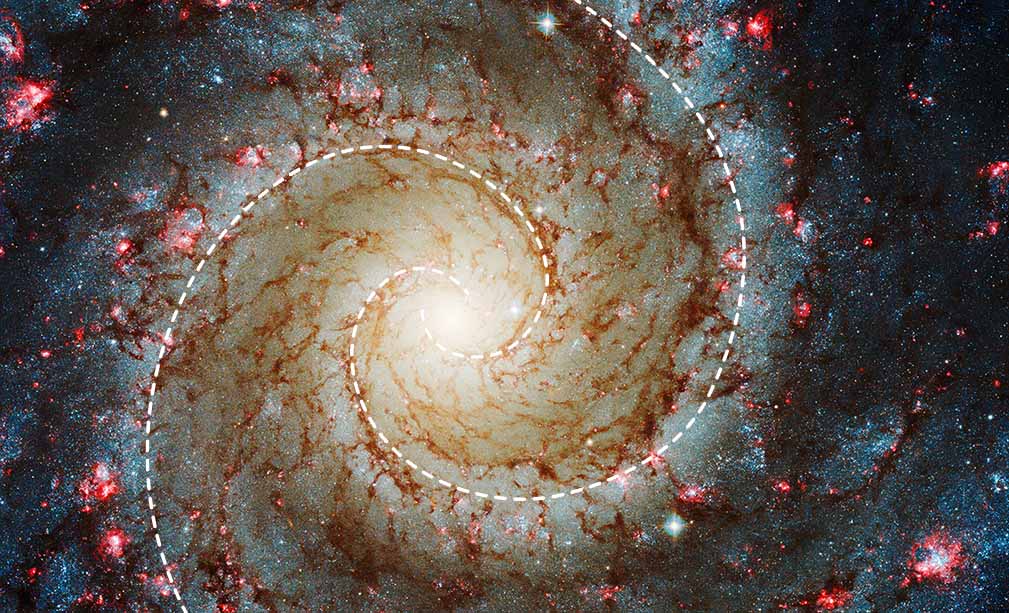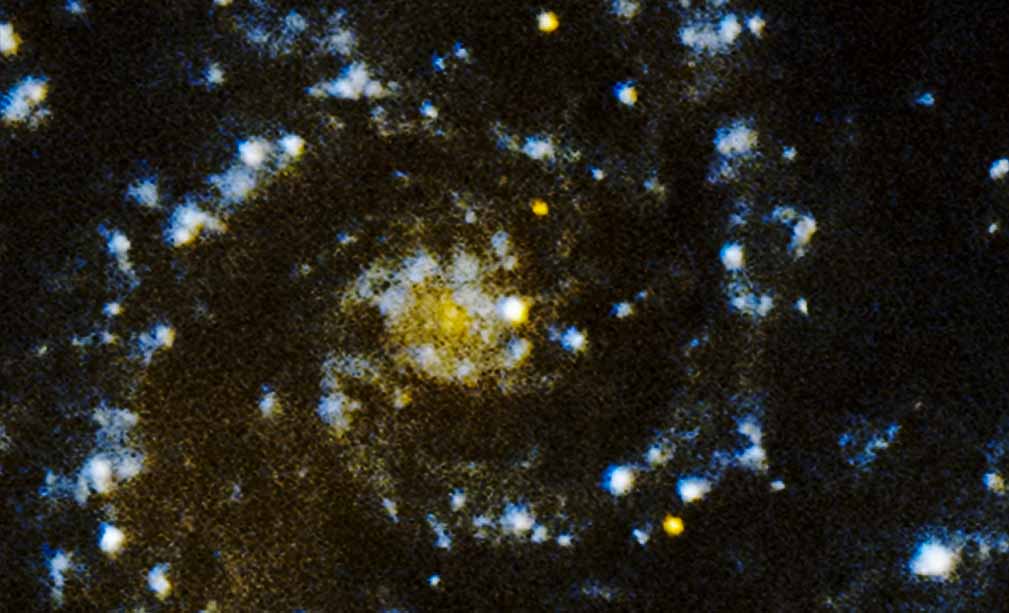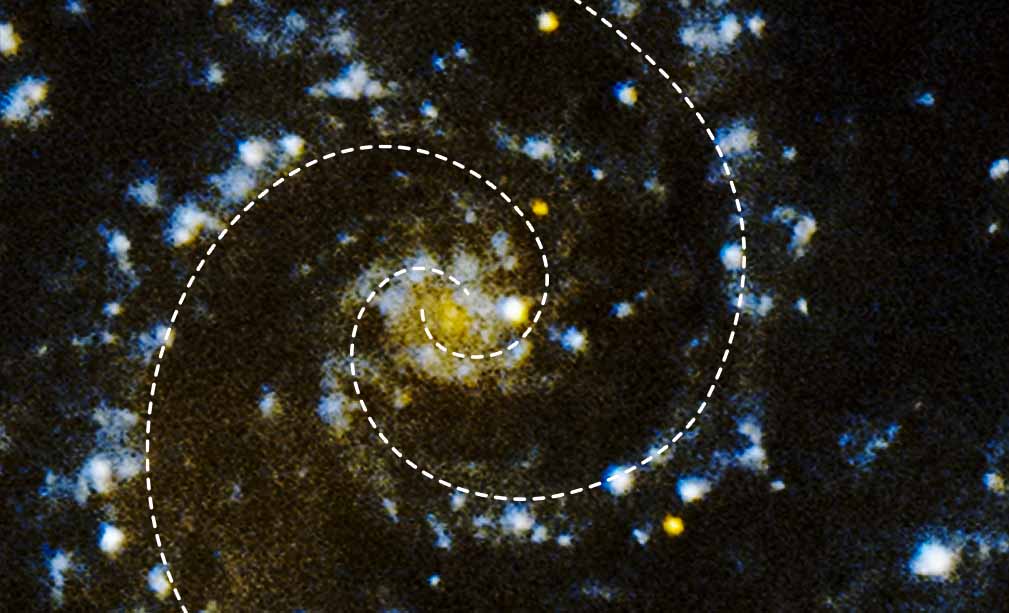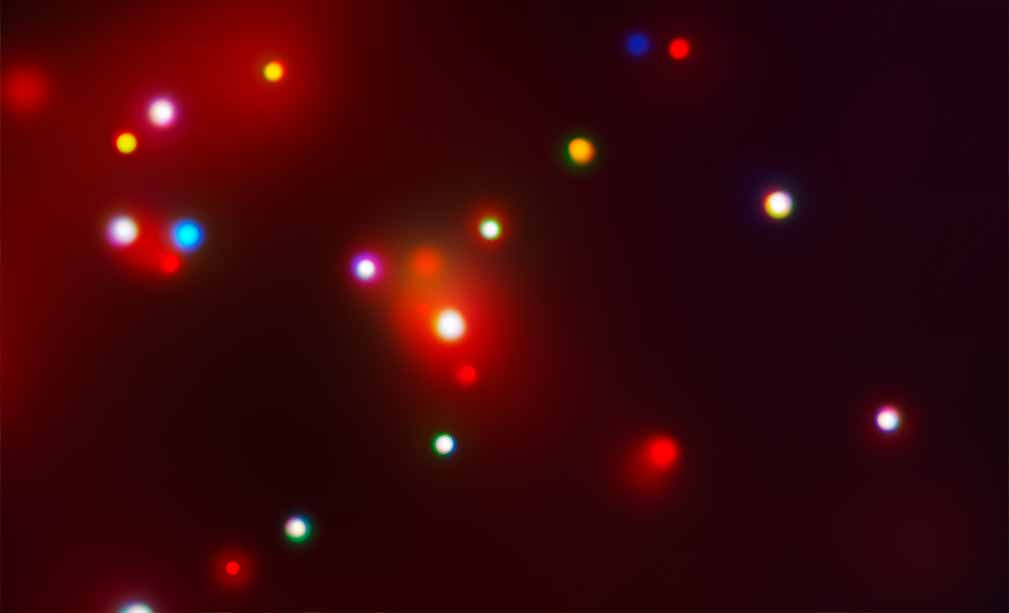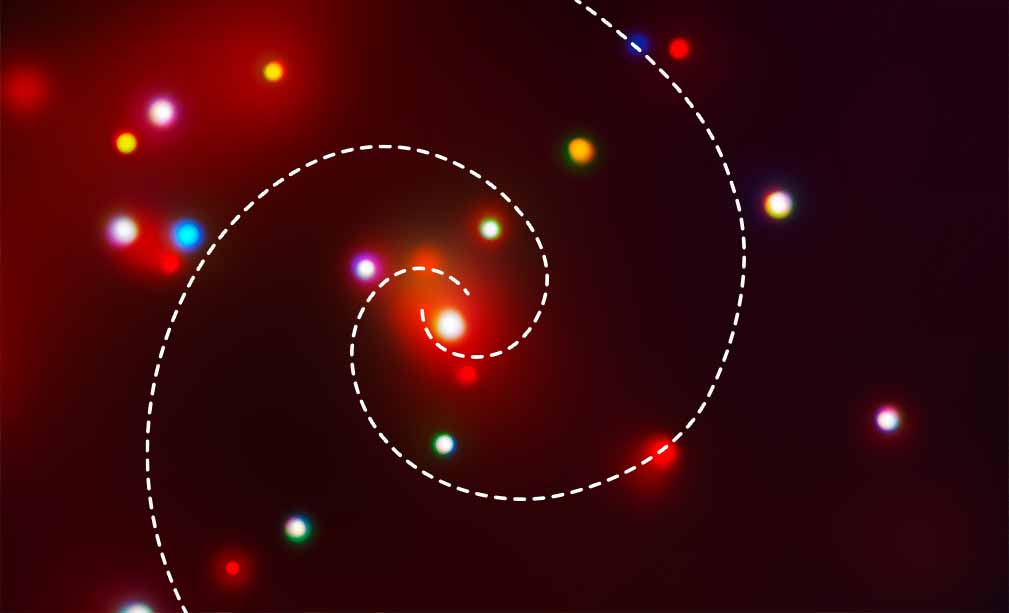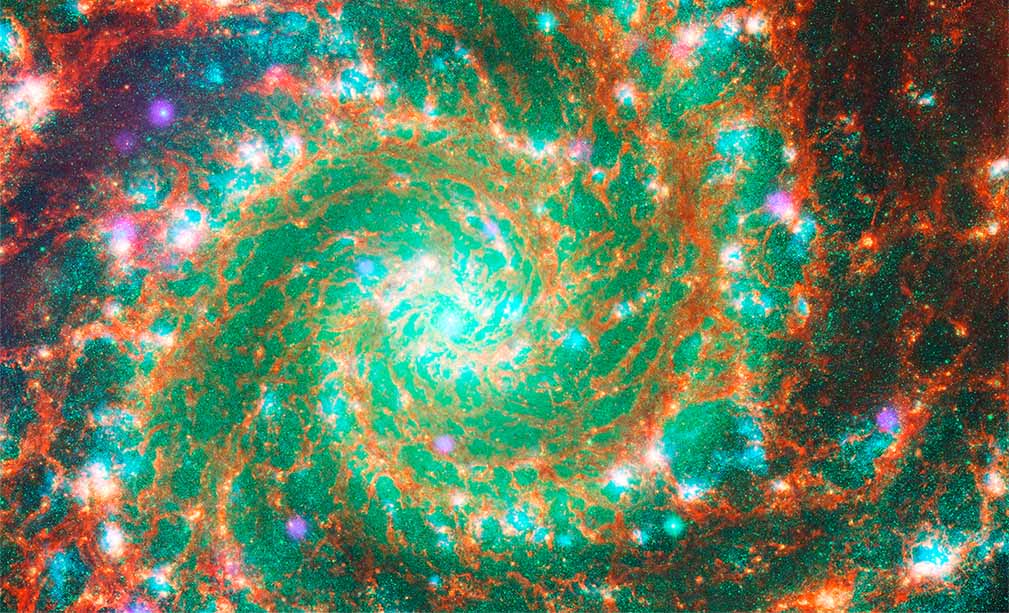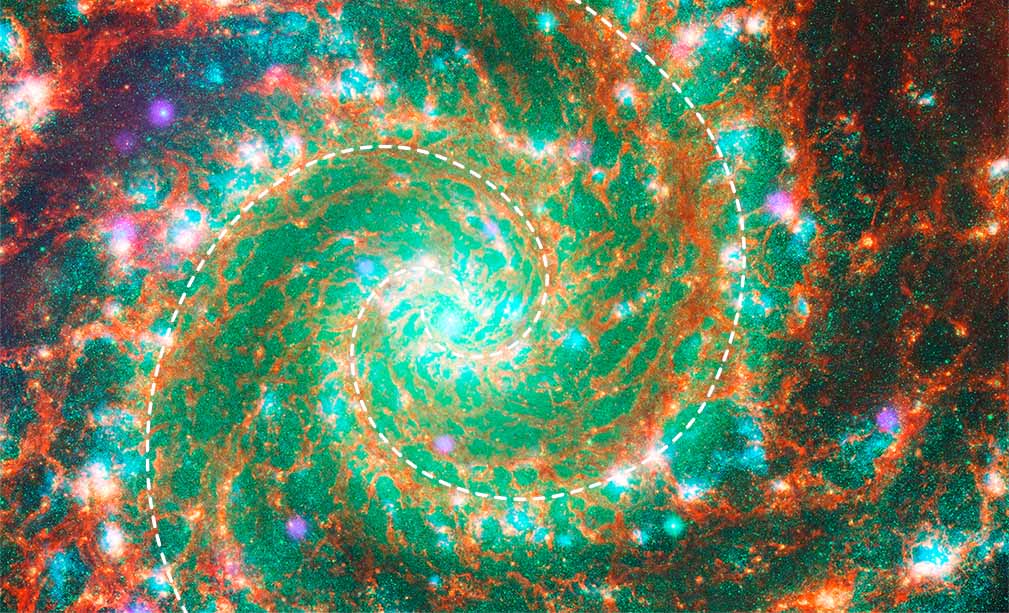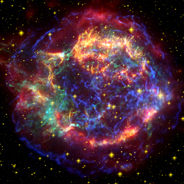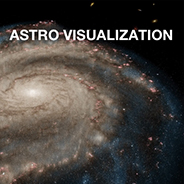Interactive Overview
Slider Interactive: A series of labeled images of a spiral galaxy with captions. Below the caption area is a horizontal slider bar with five labeled stops and a solid white circle indicating which image is displayed above. Dragging the white circle right and left along the slider bar causes the image, labels, and caption to change. The change occurs gradually as one image, along with its associated caption and labels, fades out and the next fades in. A toggle button to the upper right of the image turns the image labels off and on. Some labels are in the form of text with arrows pointing to specific features in the image. Other labels are graphic overlays.
All five stops show the same portion of the same spiral galaxy. The perspective is face-on, with the core of the galaxy in the center of the image and the two galaxy arms winding counter-clockwise out from the core toward the edges of the image. The view of the galaxy is cropped such that portions of each arm are cut off and the outermost regions of the galaxy are out of view.
Each of the five images shows different forms of light emitted from the galaxy. The images differ in color and resolution, as well as the large-scale structures and detailed features that are visible.
Slider Stops
From left to right, the slider stops are labeled: Mid-infrared, Visible, Ultraviolet, X-ray, and Multi-wavelength.
Summary of Slider Stops
Sliding left to right reveals the following:
- “Mid-infrared” stop shows the spiral pattern of the galaxy with two blue-gray arms winding around a blue core. Pink clusters of stars are scattered throughout the image. This is the initial image shown when the interactive is loaded.
- “Visible” stop shows the distinct spiral pattern with the two galaxy arms of brown, yellow, red, and blue winding around a bright yellowish-white core. Dust is visible as brown streaks between the two spiraling arms that appear lattice-like in structure.
- “Ultraviolet” stop shows fuzzy blobs of blueish white that form a vague spiral pattern around a yellowish center. The galaxy’s two spiral arms are largely not discernable in this image.
- “X-ray” stop shows a scattering of glowing circles of different colors, including red, orange, yellow, green, blue, and purple. The circles do not appear to be arranged in any clear pattern. The center of the galaxy and areas to the upper-left of the image have a reddish cloudy haze against a black background.
- “Multi-wavelength” stop shows a very distinct spiral pattern with bright colorful arms of red, green, and blue winding around a bright blue-white core.
Stop 1: Mid-infrared
Image Description: Mid-infrared
Color image from the Webb Space Telescope of several wavelengths of mid-infrared light from the spiral galaxy M74. The galaxy core in the middle resembles a glowing blue-colored eye, with a relatively bright whitish-blue point near the center, surrounded by smaller, blue points of starlight. The structure of both the core and the inner tips of the spiral arms are clearly visible in this image.
Winding counter-clockwise around the core, the two spiral arms are dominated by lanes of blue-gray dust. The pattern drawn by the dust resembles the cross-section of a chambered nautilus: with curved veins of dimmer blue-gray connecting the relatively bright, dense spine of each arm. Some of the bubble-like spaces between the dust veins are almost circular, while others are elongated along the spiral.
Scattered along the bright spine of each arm are clumps of bright white light surrounded with a red glow. Tiny blue dots, foreground stars, are scattered throughout.
Labels: Mid-infrared
There are three text labels and one graphic overlay. A label that reads “Lanes of warm dust” points to a portion of blue-gray along the left spiral arm, about halfway out from the core. The label “Old stars in dust-free core” points to the small blue-speckled oval-shaped region in the center of the image. The label “Bubble carved by hot stars” points to a large, empty-looking, circular, region located along the right spiral arm, about halfway out from the core. Two dashed white lines wind in a counter-clockwise direction out from the center and trace the galaxy’s two spiral arms. The spiral on the left begins to the left of the center, winds down and then up, counter-clockwise around the core, ending on the bottom left side of the image. The spiral on the right begins to the right of the center, winds up and then down, also counter-clockwise around the core, ending near the middle of the upper edge of the image.
Caption: Mid-infrared
Lanes of dust and knots of star formation glow in infrared, tracing the galaxy’s spiral arms.
Stop 2: Visible
Image Description: Visible
Full-color Hubble Space Telescope image of various wavelengths of visible light from the spiral galaxy M74. The perspective and field of view are the same as in the “Mid-infrared” stop. The galaxy core is bright yellowish-white, decreasing in brightness with distance from the center. The core appears very large and hazy, with no details apparent in the center. Winding counter-clockwise around the core are two distinct spiral arms traced by brown wispy veins of dust; tiny blue stars that form a blueish fog between the brown dust lanes; and small clumps of blueish-white stars ringed with bright red gas. The brown lanes and veins of dust are most prominent in the inner region, just outside the core. The small blue stars and red knots of gas become more prominent with distance out from the core. Several bright foreground stars with distinct cross-shaped diffraction patterns are scattered across the image.
Labels: Visible
There are three text labels and one graphic overlay. A small clump of blueish-white surrounded by bright red is labeled “Knot of glowing gas.” This knot is located along the left arm, about halfway out from the core. A wispy patch of dark brown is labeled “Dust blocking starlight.” The label is placed about one-quarter of the way out from the core. A glowing band of tiny blue lights is labeled “Young blue stars in spiral arm.” The label is placed along the right spiral arm, about three-quarters of the way out from the center. The two dashed white lines seen in the prior “Mid-infrared” stop are seen here, winding in a counter-clockwise direction out from the center and tracing the galaxy’s two spiral arms.
Caption: Visible
Shadowy lanes of dust absorb and scatter visible light from stars.
Stop 3: Ultraviolet
Image Description: Ultraviolet
XMM-Newton image of ultraviolet light from the spiral galaxy M74. The perspective and field of view are the same as the other images. This image is much less detailed than the mid-infrared and visible images. The spiral shape of the galaxy is apparent, but the resolution is significantly lower and some structures are not visible at all. Unlike the other images, which are full-color, this image consists of only two colors: blue and orange.
The galaxy core in the middle of the image is mostly orange and surrounded by fuzzy blobs of blueish-white. Additional blue-white clumps are arranged to form two broad and discontinuous spirals winding counter-clockwise around the core. Some of the bright blue-white clumps correspond to the red-ringed knots in the mid-infrared and visible images. Others correspond to patches of tiny blue stars that form the blueish haze seen in the “Visible” stop. Several discrete circular orange blobs correspond to the bright foreground stars in the “Visible” stop. The lanes of dust seen clearly in the mid-infrared and visible images do not appear at all in this image.
Labels: Ultraviolet
There are three text labels and one graphic overlay. One of the blue-white clumps on the left spiral arm is labeled “Knot of hot, newly formed stars.” This label is pointing to the same place as the label in the “Visible” stop that reads “Knot of glowing gas.” Another blue-white clump, on the right spiral arm, is labeled “Massive stars with short lives.” This label is pointing to the same place as the label in the “Visible” stop that reads “Young blue stars in spiral arms.” The orange region at the center of the image is labeled “Older, cooler stars in the core.” This label points to the same place as the label in the “Mid-infrared” stop that reads “Old stars in dust-free core.” The two dashed white lines seen in the prior stops are seen here, winding in a counter-clockwise direction out from the center and tracing the galaxy’s two spiral arms.
Caption: Ultraviolet
Hot stars emit ultraviolet energy that causes gas to glow with visible and infrared light.
Stop 4: X-ray
Image Description: X-ray
Color image from the Chandra X-ray Observatory of several wavelength-bands of X-ray light from the spiral galaxy M74. Although the perspective and field of view are the same as in the other images, this image is different from the mid-infrared, visible, and ultraviolet images in terms of color, visible structure, and detail.
Scattered across the image are glowing circles of various colors: bright red, bright blue, yellowish-orange, and white. The circles vary in size, but are typically much larger than the point-like stars in the “Mid-infrared” and “Visible” stops. They are somewhat fuzzy, but have more distinct outlines than the blue-white clumps in the “Ultraviolet” stop.
The largest of these objects is located in the center of the image and appears to mark the core of the galaxy. It is bright white and is surrounded by a bright but diffuse red glow. This glow is present around some of the other objects and across the upper left portion of the image. Unlike in the prior stops, the spiral arms of the galaxy are not apparent in this image.
Labels: X-ray
There are three text labels and one graphic overlay. A label pointing to the diffuse red glow in the upper left portion of the image reads “Super-hot gas.” One of the pink circles to the upper left, away from the left spiral, is labeled “Dense core of dead star.” A bright blue circle located next to the left spiral is labeled “Blue = highest energy X-rays.” The two dashed white lines seen in the prior stops are seen here, winding in a counter-clockwise direction out from the center. Some of the bright objects in the image are located along the white dashed lines, but most are not.
Caption: X-ray
Gas gives off X-rays as it falls into the super-dense core of a dead star: a black hole or neutron star.
Stop 5: Multi-wavelength
Image Description: Multi-wavelength
This image is a composite of all the wavelengths explored in other stops of the interactive. The perspective and field of view are the same as in all of the other images. Each form of light is shown in a different color. The mid-infrared light captured by the James Webb Space Telescope is shown as red. The red is concentrated in the dust lanes and veins along and between the spiral arms. The visible wavelengths of light from the Hubble Space Telescope are shown as green. The green is most prominent in the points of starlight between the veins of dust within and between the arms. The ultraviolet wavelengths of light collected by XMM-Newton are shown as blue. The blue is most apparent in the fuzzy clumps along the spiral arms. The bands of X-ray light from the Chandra X-ray Observatory are shown as purple. Glowing orbs of purple are scattered here and there along and between the arms.
The bright colors and distinct, complex spiral pattern give the image a psychedelic feel. The image is brightest at the center. The brightness decreases and overall contrast increases with distance from the center. Most of the structures that are visible in the individual images are present in this composite. Some structures, like the orange-brown lanes of dust and the bubbles between the veins of dust, are very pronounced. Others, like the red knots that glow in visible and infrared, the blueish clumps of ultraviolet light, and the purple sources of X-ray light overlap and are hard to differentiate.
Labels: Multi-wavelength
There are three text labels and one graphic overlay. In the upper left, away from the left spiral arm, a blue-white point of light surrounded by a purple glow is labeled “Dead stars consuming gas.” This label points to the same place as the label in the “X-ray” stop that reads “Dense core of dead star.” A blue-green region between the two dashed white lines is labeled “Stars between spiral arms.” A region of bright orange-brown along the right spiral is labeled “Dust forming new stars.” The two dashed white lines seen in the prior stops are seen here, winding in a counter-clockwise direction out from the center and tracing the galaxy’s two spiral arms.
Caption: Multi-wavelength
A composite of visible and invisible light shows relationships between dust, gas, and stars.
